What flowers can be sown before winter - top 20 best options
With the onset of spring, work begins on the improvement of the personal plot. I would like the flowerbed to bloom with bright colors as quickly as possible, to form a recreation area. You can get flowering 1-2 weeks earlier by sowing flowers in the fall. What flowers can be sown before winter, and how sowing is carried out correctly, is described in the article.
Why sow flowers before winter
Sowing seeds in autumn provides not only early flowering, but also makes it possible to get seedlings. Those who germinate planting material at home know that caring for crops in containers requires a lot of attention.
It is necessary to constantly monitor the degree of watering, the level of lighting, and the temperature regime. When sowing in autumn in open ground, you just need to take care of fertilizing the soil and warming the beds with mulch or other shelter.
Reference! Seedlings obtained from sowing in the open field before winter differs from domestic ones in resistance to adverse weather conditions and diseases.
Sowing advantages and disadvantages
Planting seeds in the fall has several advantages over planting in spring.
- Sowing before winter provides natural conditions for the development of flowers. In fact, the seeds undergo vernalization, which makes the shoots strong.
- Lack of dependence on spring weather, late frosts, which do not allow timely planting work.
- Abundant soil moisture after the snow melts will not provoke seed rot.
- There is no need to sprout seedlings at home, cluttering up window sills and other spaces in the home with containers.
- When planting in autumn, natural selection occurs. Only strong seeds germinate, from which plants resistant to external factors are obtained.
- After germination of the shoots, the excess is removed. The remaining shoots begin to form a taproot system that lies deep in the soil. When picking, the root turns out to be fibrous.
- The seedlings obtained during autumn planting are characterized by high resistance to cold and drought.
In fairness, it is worth clarifying that a winter landing also has disadvantages. Among them:
- only cold-resistant varieties of flowers are suitable for autumn planting;
- with premature warming, the process of seed germination may begin, the nearest frost will destroy the shoots;
- too important soil has a negative effect on crops, the risk of rotting or fungal infection increases;
- the rate of seed germination decreases, which is due to unfavorable germination conditions.
Reference! When sowing before winter, it is necessary to increase the volume of planting material by about 30% in order to compensate for the low germination of seeds.
Requirements for flowers that are sown before winter
The choice of flowers that can be sown before winter is incredibly large. But not all cultures are suitable for certain climatic features of the region. The following requirements are imposed on seeds:
- high cold resistance;
- unpretentious agricultural technology;
- good seed germination.
It is also important to pay attention to the appearance of the planting material. It should be dry and free from mold and mildew. From the total number of seeds, large specimens are selected without spots and irregularities.
Often, herbaceous plants have microscopic grains that cannot be seen. When sorting, it is enough to discard suspicions of the presence of mold. It can be recognized by its grayish tint and musty odor. Many varieties suitable for subwinter planting require stratification.
Top 20 flowers that can be sown outdoors before winter
For planting for the winter, you can choose varieties of annual crops and perennials.
An annual plant characterized by simple agricultural techniques. Due to its frost resistance, the seeds do not deteriorate after sowing in the fall. There are no special requirements for the soil. The seed is applied to the seedling bed or a permanent place.
Depending on the variety, there are annual and perennial flowers. There are conflicting opinions on sowing these flowers for the winter. This is because the seeds need warmth to germinate. In damp and cool ground, they can simply rot. Favorable conditions for survival are possible only in regions with warm winters and early spring. In the northern regions, it is recommended to grow flowers in greenhouses before winter. In this case, the crops are covered with a layer of peat and a film.
Perennial with a powerful branching structure. The wild rose is an unpretentious flower. It is available to grow in flower beds, containers and borders. You need to choose a place in a well-lit area. Only depleted soil should be fertilized before planting. Seeds are applied directly to the designated area. After planting, the soil surface is mulched.
It is a perennial herb. Sowing Greicher is necessary in neutral soil, but not acidified. Due to the scanty size of the seeds, it is enough to scatter them over the surface without deepening. With a strong immersion, the grains simply will not germinate. The agrotechnology of the plant is quite troublesome. When choosing this variety, it is worth considering that the seeds do not germinate for long.
Agrotechnology of annual culture is complex. Before sowing, the planting material needs to be stratified. You need to store it in the refrigerator. Seeds are introduced into loose soil (they will not germinate in dense soils). Sowing is carried out in a permanent place, since the culture does not like transplants. The grains are deepened by 2-3 mm. At the onset of frost, the soil is covered with a layer of mulch.
The seeds need cold stratification. A sunny area protected from drafts and wind is chosen for sowing. Before planting, the soil is enriched with wood ash or lime to neutralize acidity. The crops are deepened by 3-4 mm. For the winter, the garden bed is mulched. Shoots can be expected no earlier than May-June.
- Kosmeya
The annual plant reproduces well by self-seeding, so there should be no problems with planting. Usually, the grains are plentifully introduced to a permanent place. In the spring, excess seedlings are transplanted or removed. The site is pre-loosened and fertilized. You should not overdo it with the nutrient mixture, otherwise all forces will go to building up the green mass (to the detriment of flowering).
- Carpathian bell
Perennial crops are usually sown just before winter. The soil should be loose, the environment neutral. It is recommended to use humus, peat and sand as fertilizer (if the soil is very dense). In the spring, after the appearance of seedlings, the planting is thinned out.
- Aster annual
Sowing in the fall reduces the risk of developing fungal diseases in flower beds with these flowers. For normal vegetation, a place for planting is chosen without drafts and thick shade. The soil should be nutritious and lightweight. It is advisable to change the site every year. It is better to plant flowers after marigolds or calendula. It is recommended to raise the bed 15-25 cm above the soil surface. This way it will be possible to avoid rotting of the roots due to stagnant moisture.
There are two types of culture.One of them is annual (two-horned), the other is perennial (levkoy). Seeds can be sown in both cases before winter, if the growing region excludes severe frosts. For convenience, the seeds are mixed with sand, so it is easier to distribute planting material over the garden bed. After the emergence of shoots, thinning is done, leaving 20-25 cm between the shoots.
Annual. Intensive growth is observed when growing in sunny areas. Culture harmoniously complements any arrangement in a flower garden. For normal vegetation, a fertile soil of a lightweight structure and the absence of acidification is required. The sowing site for the winter is covered with a layer of mulch. In early spring, it is important to remove the insulation so that the seeds do not have time to soak.
Perennial. Usually grown in seedlings. The culture develops well in open flower beds. Requirements for soil and place of growth are standard.
- Loburyalia sea
Herbaceous annual, which pleases with rapid flowering until the end of the warm season. Seeds are applied in the fall after the first light frost. The soil is prepared in advance: fertilizer is applied, loosened, and neutralizes the acidic environment. The seeds are stored in a dry place for a short period. After 2-3 seasons, they lose a large percentage of germination.
- Eschsholzia california
Perennial, characterized by unpretentiousness and good adaptation to different climatic conditions. The plant can be transplanted or sown directly to the flower bed. After planting, cover the bed with a layer of mulch. In the spring, after emergence, thinning and replanting are performed (if required).
- Mallow
The herbaceous plant is a perennial. Thanks to this, you can arrange flower beds or patios so that they will delight the eye for several seasons. Sowing is planned for October. A distance of 40 cm is maintained between shallow holes (about 3 cm). Several seeds are placed in each cavity.
- Primrose
Despite the popularity of the plant, it is not easy to get it from seed. A perennial flower is picky about the composition of the soil, weather conditions. The absence of weeds is also important. Seeds are stratified before sowing. It is worth considering that the germination rate of the planting material is low.
- Nivyanik
Perennial seeds are characterized by high frost resistance. When sown in the fall, strong shoots are obtained, which give a quick growth of greenery. The place is chosen permanent or a hotbed. Soil requirements are standard. Garden chamomile combines perfectly with other herbaceous plants and undersized shrubs.
The annual crop is grown in open beds and under cover. It is distinguished by its endurance and cold resistance. The only significant drawback is the fact that when it gets warmer, the sprouts actively break out of the soil. Seedlings die at the first frost. Experienced gardeners recommend covering the planting with a film on the frame.
The plant is a perennial, characterized by high adaptive qualities. Flowers are planted on flower beds, borders, containers. Unpretentiousness and intensive development of young growth are the main advantages of culture. Sowing before winter is well tolerated. When grown in cooler climates, mulch cover is required. Other features: seeds stratify, young shoots do not like transplanting, so sowing is carried out in a permanent place.
The herbaceous annual adorns flower beds, patios and borders. Looks good in decorative containers too. An early and abundant bloom is obtained when sown in the fall. The place is chosen for permanent growth, the plant does not tolerate transplanting well. The planting must be protected from severe frosts and waterlogging.
What flowers to choose, depending on the growing region
When choosing a variety of flowers, you need to take into account that the culture can have varieties that are characterized by different cold resistance.Iberis, for example, has species that thrive in all climates and are intended only for cultivation in the south. Marigolds of almost all varieties tolerate wintering well in the middle zone of the country.
The following flowers are suitable for sowing before winter in the Moscow region:
- hyacinths;
- daffodils;
- pansies;
- mallow;
- asters, etc.
In any conditions, you can plant the following crops:
- Adonis;
- agrostemma;
- field cornflower;
- delphinium;
- calendula;
- lavater.
Florists recommend the following crops for regions with a harsh climate, resistant to frost and an unfavorable environment:
- lady's nigella;
- escholzia;
- cochia;
- cosme;
- maned barley;
- dimorphotek.
These plants easily endure adverse weather conditions, providing friendly seedlings in the spring.
Where to plant flowers before winter
Most herbaceous crops do not like replanting. Therefore, it is better to sow seeds in the place where you plan to break the flower garden. It is also allowed to use special containers in which it is convenient to grow seedlings. Preparatory work includes the following activities:
- weeding;
- digging up the soil;
- fertilization;
- leveling the platform with a rake.
If it is supposed to plant plants in the form of some kind of pattern, the corner of the boot should outline the boundaries with a depth of 10 cm.Thus, after the snow and rains melt, the outline will not be lost. After drawing individual zones of the flower garden, you need to make grooves for the seeds.
After the planting material has been introduced, the surface is covered with a layer of humus or peat. It is not recommended to cover the seeding with soil. By spring, the soil will be compacted, and in dry weather it will also be covered with a crust. Seedlings cannot get through such a cordon.
You can also sow flower seeds before winter in pots, plastic and ceramic containers. They are placed in greenhouses, under a film shelter or right in the garden. In the latter case, it is required to install a high bed of boards with filling the free space with humus, compost or peat. With such insulation, winter frosts are not terrible for seeds.
Optimal timing
At the end of the warm period, you should not relax. In the fall, you can start sowing flowers in flower beds and other landscape objects. It is better to start laying out a flower garden in late October - early November, in the southern part of the country - in the second half of November.
Success in good germination of seeds lies precisely in the timing of planting. But no one will recommend strict numbers, since weather conditions are taken as a basis. The ground should be slightly frozen. When the seeds are placed in warm soil, they enter the active growth phase. And this is completely useless before winter. Seeds do not germinate at soil temperatures of 5 degrees and below.
When determining the timing of sowing, you can focus on the air temperature. It should not be higher than 1-3 degrees. Florists also keep track of the weather forecast. Do not rush if prolonged warming is expected after freezing. Following popular beliefs, it is worth starting planting work after the cherry leaves are dropped.
Features of planting before winter
The number of seeds is calculated taking into account the decrease in germination, which is a natural factor when planting in winter. Annual crops take 50% more than the usual rate, perennial crops - 20-25%.
Small grains (such as snapdragons) must be sealed with immersion in the soil up to 1 cm. Medium-sized seeds are buried by 2 cm, large ones - up to 4-5 cm.
During the winter, the soil is well compacted, which may prevent the seedlings from breaking through. This can be prevented by lightening the soil with peat, covering it with mulch after planting. For even distribution of seeds, it is recommended to mix them with sand.
Reference! When sowing several types of flowers, it is recommended to mark the beds with tabs on which the name of the variety is indicated. This will help avoid trampling crops.
Seeding does not need watering.Swollen seeds will germinate after a short-term warming. In the spring, they will have enough moisture from melted snow and rains. In case of heavy rainfall, it is recommended to cover the beds with foil to prevent decay of the planting material.
Crops must be covered with a layer of mulch. This solution eliminates the overgrowing of the site with weeds, through which young shoots cannot break through. Mulch also prevents birds from eating seeds.
When planting bulbous flowers, it should be borne in mind that the planting material winters better in a permanent place of growth. Therefore, the tubers should not be dug up annually. In the same flowerbed, they spend up to 4 years without transplanting. This does not in any way affect the decorativeness of flowering, the parameters of the inflorescences and other varietal characteristics.
Before planting, you need to loosen the soil, apply fertilizers. The level of deepening depends on the size of the tuber itself and the density of the soil. The bulb is immersed in loose soil to a level corresponding to three of its heights, in dense - only two.
Planting according to the rules will ensure good germination of shoots in spring and friendly flowering throughout the warm season.
Tips on the topic from an experienced florist:



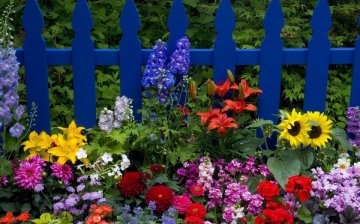
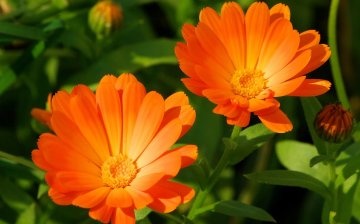
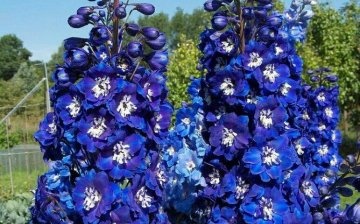
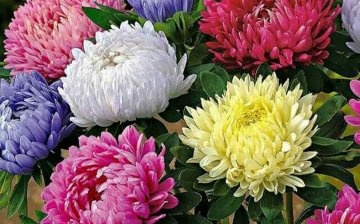
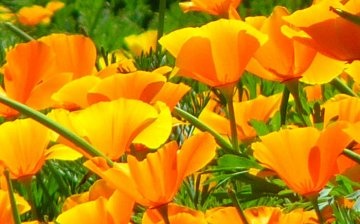







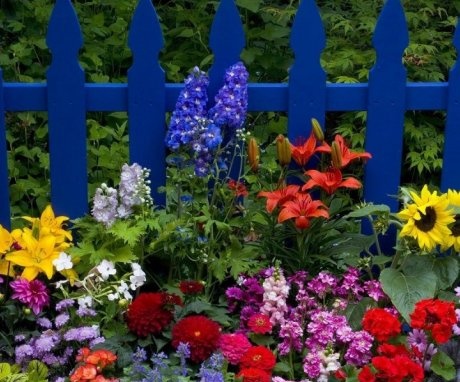

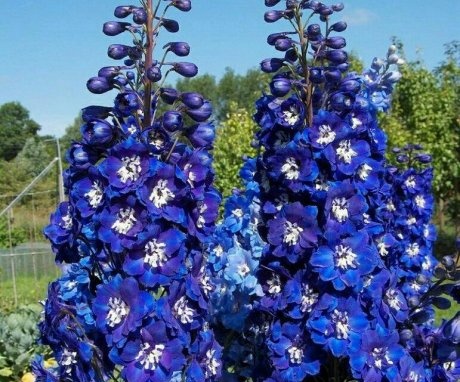
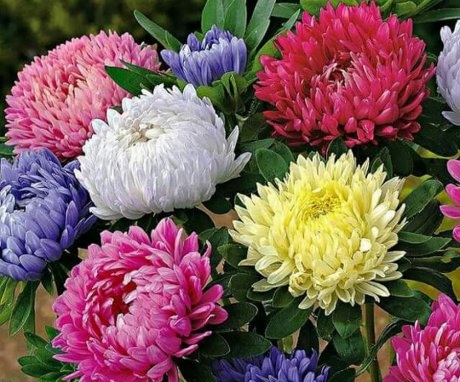
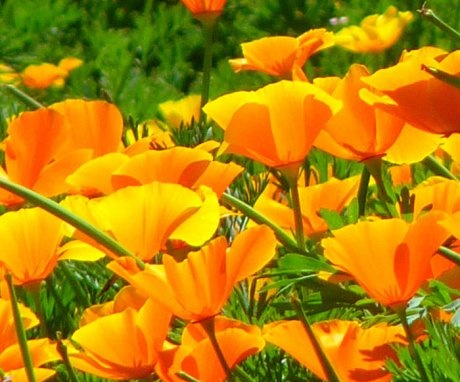

I have marigolds and chamomile, but they themselves are sown in the fall and germinate well in the spring. Before winter I plant, only tulip bulbs. I choose large, even forms and in May they always bloom together.